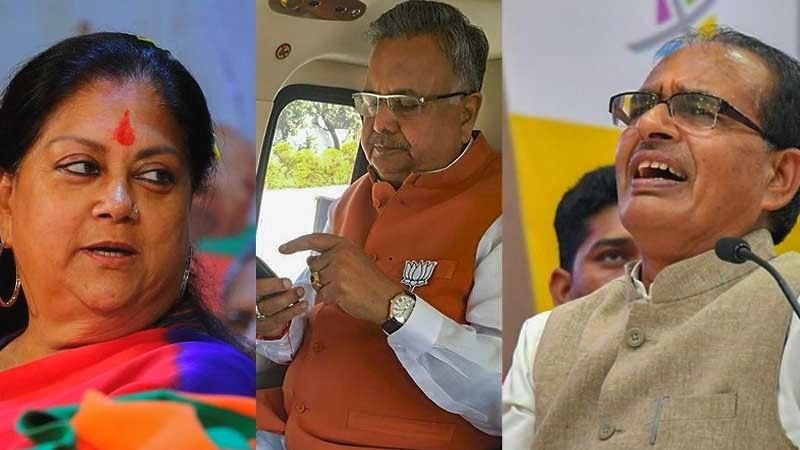
Incumbents Shivraj Singh Chouhan (MP), Vasundhara Raje (Rajasthan) and Raman Singh (Chhattisgarh).
Credit: PTI photo
If the upcoming assembly elections in Madhya Pradesh, Rajasthan, Chhattisgarh, Telangana, and Mizoram are compared with a football match, the Bharatiya Janata Party (BJP) may have to worry about the missing playmakers, the midfielders, who set up the game for the strikers to finish. As is true for football, the accolades go to the strikers, but the coaches and strategists know that the midfielders are the true playmakers.
Prime Minister Narendra Modi is indisputably the lead striker for the BJP. Union Minister for Home Affairs Amit Shah is another striker, who toils hard to fall back in the midfield to strengthen the weak flanks. When opponents are weak, the BJP pulverises its rivals, with Modi and Shah making it a one-sided match.
Gujarat is a good example of this one-sided match where Modi is enough to win the BJP the assembly elections. Modi’s almost 13 years as Chief Minister has created enormous goodwill for the BJP that it does not matter if the party is having its third Chief Minister since 2014.
The Gujarat experiment of replacing seasoned leaders with young faces is arguably at the core of BJP’s vision for next 10 years. This ‘Gujarat model’ has worked in the smaller states of Uttarakhand, Goa, and Tripura where BJP won the polls with relatively new faces. However, when applied in Karnataka, it backfired despite Modi’s electioneering blitzkrieg, and Shah pulling all stops.
In the poll-bound states, the BJP risks leaving the midfield in the hands of the leaders who are yet to prove their mettle. For more than a decade now the electoral turfs of Madhya Pradesh, Chhattisgarh, and Rajasthan were nursed for the BJP by towering state leaders — Shivraj Singh Chouhan, Raman Singh, and Vasundhara Raje respectively. But the BJP seemingly wants to look beyond them, as part of the leadership transition strategy.
With Chouhan missing out from the first three lists of candidates for Madhya Pradesh, while Union Ministers and Lok Sabha MPs have joined the electoral fray, the incumbent Chief Minister has his chin down with the BJP central leadership sending a message that Chouhan is not the only contender for the chief minister’s post if BJP wins the elections. Beyond Chouhan, the BJP has Narendra Singh Tomar, Prahlad Singh Patel, and Faggan Singh Kulaste — all influential leaders in different regions across the state, but lack Chouhan’s across-the-state appeal.
Raje in Rajasthan was missing from the ‘Parivartan Yatras’, even in her home turf of Jhalawar. Her most immediate rival is Union Minister Gajendra Singh Shekhawat. Union ministers Arjun Ram Meghwal and Ashwini Vaishnav also nurse ambitions in state politics. Former Union Minister Rajyavardhan Rathore also stays in focus. Yet, none of them could build grounds against the Ashok Gehlot-led government in last five years, with onus falling on Modi and Shah to count the failures of the Congress government. With Raje on the sidelines, BJP’s principal challenge in Rajasthan remains to erase memories of how lacklustre the BJP has been in the opposition these five years.
The BJP leaders sent from other states to build poll grounds in Chhattisgarh lament that the party had been highly ineffective as an Opposition against the Bhupesh Baghel-led Congress government. For BJP, the challenge in both Rajasthan and Chhattisgarh is to cover up for the lack of a visible Opposition in the last five years, principally because of the missing second-rung leaders. When it comes to Telangana, a problem from a faction-ridden state unit aside, BJP seems to be experimenting with Union minister G Kishan Reddy sent to helm the state unit only a few weeks ago. The removal of Bandi Sanjay Kumar who was vociferous against Telangana government has given Congress a chance to allege that there is a tacit understanding between the BJP and the ruling Bharat Rashtra Samithi.
The BJP is a junior partner of the Mizo National Front (NMF) in Mizoram, and is still searching for a base in the northeastern state.
With mid-level leadership not yet rising to the occasion, BJP risks heavily banking on a top-heavy election campaign with Modi, Shah, and party chief JP Nadda. If the BJP’s opponents had been weak on the lines of Gujarat, this chink in the national party’s armour would not have been as glaring as it is now. In Madhya Pradesh, Rajasthan, Chhattisgarh, and Telangana, BJP’s rivals are battle-proven political leaders with strong regional connect. The likes of Kamal Nath, Ashok Gehlot, Bhupesh Baghel, and K Chandrashekhar Rao are formidable opponents. Modi will have to square off with them, as he did with Siddaramaiah in Karnataka — and this time, hope for a different result.
(Manish Anand is a Delhi-based journalist.)
Disclaimer: The views expressed above are the author's own. They do not necessarily reflect the views of DH.